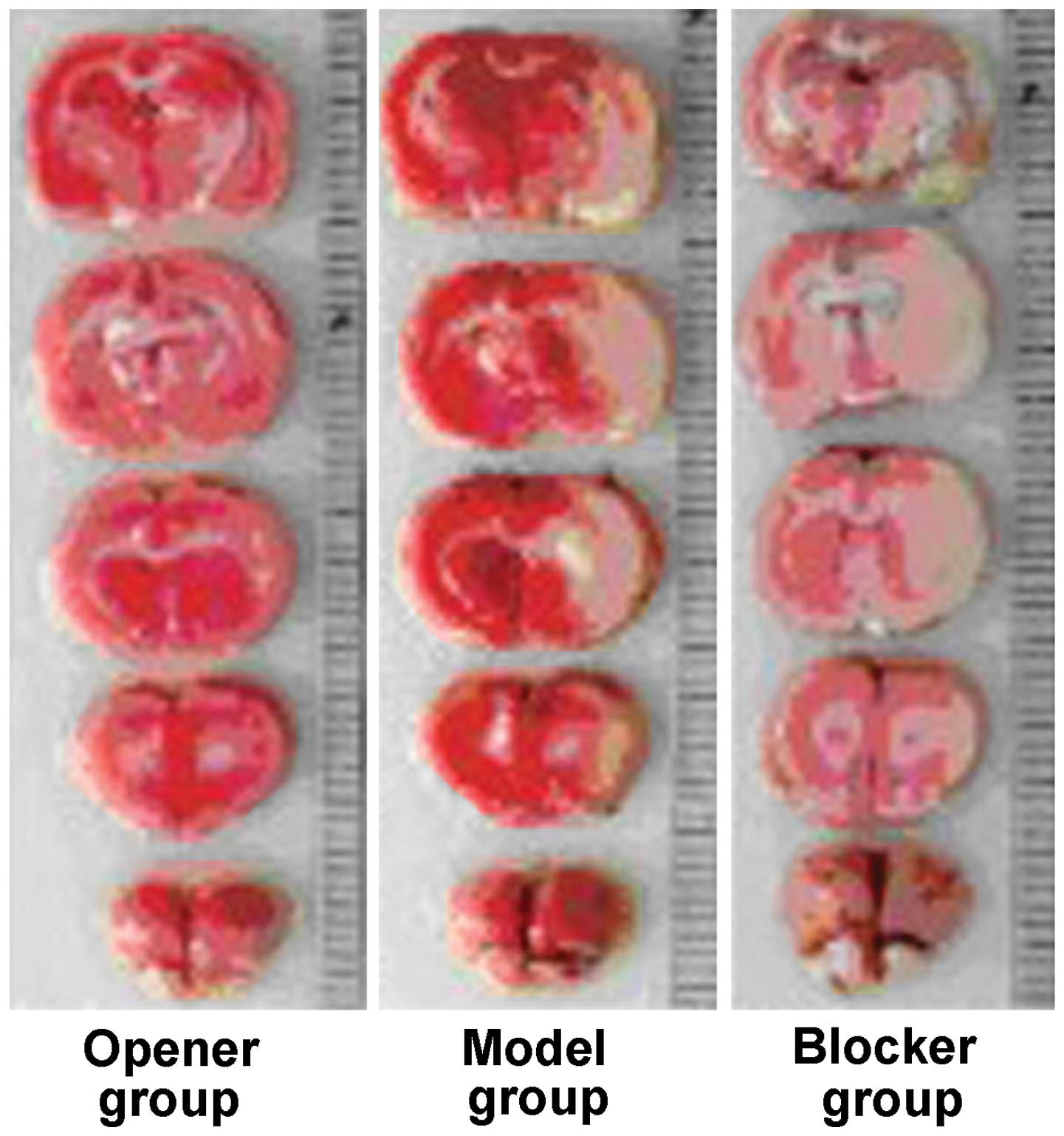|
1
|
Liu Y, Wan Y, Fang Y, Yao E, Xu S, Ning Q,
Zhang G, Wang W, Huang X and Xie M: Epoxyeicosanoid signaling
provides multi-target protective effects on neurovascular unit in
rats after focal ischemia. J Mol Neurosci. 58:254–265. 2016.
View Article : Google Scholar : PubMed/NCBI
|
|
2
|
Wu C, Chen J, Chen C, Wang W, Wen L, Gao
K, Chen X, Xiong S, Zhao H and Li S: Wnt/β-catenin coupled with
HIF-1α/VEGF signaling pathways involved in galangin neurovascular
unit protection from focal cerebral ischemia. Sci Rep. 5:161512015.
View Article : Google Scholar : PubMed/NCBI
|
|
3
|
Liu Z and Chopp M: Astrocytes, therapeutic
targets for neuroprotection and neurorestoration in ischemic
stroke. Prog Neurobiol. Oct 9–2015.(Epub ahead of print).
View Article : Google Scholar
|
|
4
|
Ran YH and Wang H: Iptakalim, an
ATP-sensitive potassium channel opener, confers neuroprotection
against cerebral ischemia/reperfusion injury in rats by protecting
neurovascular unit cells. J Zhejiang Univ Sci B. 12:835–845. 2011.
View Article : Google Scholar : PubMed/NCBI
|
|
5
|
Kwon HJ, Park HS, Park SH, Park JH, Shin
SK, Song SE, Hwang M, Cho HC and Song DK: Evidence for
glucagon-like peptide-1 receptor signaling to activate
ATP-sensitive potassium channels in pancreatic beta cells. Biochem
Biophys Res Commun. 469:216–221. 2016. View Article : Google Scholar : PubMed/NCBI
|
|
6
|
Liu C, Liu Y, Shen Z, Miao L, Zhang K,
Wang F and Li Y: Sevoflurane Preconditioning Reduces Intestinal
Ischemia-Reperfusion Injury: Role of Protein Kinase C and
Mitochondrial ATP-Sensitive Potassium Channel. PLoS One.
10:e01414262015. View Article : Google Scholar : PubMed/NCBI
|
|
7
|
Dong YF, Wang LX, Huang X, Cao WJ, Lu M,
Ding JH, Sun XL and Hu G: Kir6.1 knockdown aggravates cerebral
ischemia/reperfusion-induced neural injury in mice. CNS Neurosci
Ther. 19:617–624. 2013. View Article : Google Scholar : PubMed/NCBI
|
|
8
|
Gliem M, Krammes K, Liaw L, van Rooijen N,
Hartung HP and Jander S: Macrophage-derived osteopontin induces
reactive astrocyte polarization and promotes re-establishment of
the blood brain barrier after ischemic stroke. Glia. 63:2198–2207.
2015. View Article : Google Scholar : PubMed/NCBI
|
|
9
|
Xing C, Hayakawa K, Lok J, Arai K and Lo
EH: Injury and repair in the neurovascular unit. Neurol Res.
34:325–330. 2012. View Article : Google Scholar : PubMed/NCBI
|
|
10
|
Cao S, Liu Y, Sun W, Zhao L, Zhang L, Liu
X and Yu T: Genome-Wide Expression Profiling of
Anoxia/Reoxygenation in Rat Cardiomyocytes Uncovers the Role of
MitoKATP in Energy Homeostasis. Oxid Med Cell Longev.
2015:7565762015. View Article : Google Scholar : PubMed/NCBI
|
|
11
|
Li CG, Cui WY and Wang H: Sensitivity of
KATP channels to cellular metabolic disorders and the underlying
structural basis. Acta Pharmacol Sin. 37:134–142. 2016. View Article : Google Scholar : PubMed/NCBI
|
|
12
|
Griesemer D, Zawar C and Neumcke B:
Cell-type specific depression of neuronal excitability in rat
hippocampus by activation of ATP-sensitive potassium channels. Eur
Biophys J. 31:467–477. 2002. View Article : Google Scholar : PubMed/NCBI
|
|
13
|
Qu YY, Yuan MY, Liu Y, Zhu YL and Xiao XJ:
Erratum to: The protective effect of epoxyeicosatrienoic acids on
cerebral ischemia/reperfusion injury is associated with PI3K/Akt
pathway and ATP-sensitive potassium channels. Neurochem Res.
40:8742015. View Article : Google Scholar : PubMed/NCBI
|
|
14
|
Ma YZ, Li L, Song JK, Niu ZR, Liu HF, Zhou
XS, Xie FS and Du GH: A novel embolic middle cerebral artery
occlusion model induced by thrombus formed in common carotid artery
in rat. J Neurol Sci. 359:275–279. 2015. View Article : Google Scholar : PubMed/NCBI
|
|
15
|
Sutherland BA, Neuhaus AA, Couch Y, Balami
JS, DeLuca GC, Hadley G, Harris SL, Grey AN and Buchan AM: The
transient intraluminal filament middle cerebral artery occlusion
model as a model of endovascular thrombectomy in stroke. J Cereb
Blood Flow Metab. 36:363–369. 2016.PubMed/NCBI
|
|
16
|
Umaru B, Pyriochou A, Kotsikoris V,
Papapetropoulos A and Topouzis S: ATP-sensitive potassium channel
activation induces angiogenesis in vitro and in vivo. J Pharmacol
Exp Ther. 354:79–87. 2015. View Article : Google Scholar : PubMed/NCBI
|
|
17
|
Wang S, Makhina EN, Masia R, Hyrc KL,
Formanack ML and Nichols CG: Domain organization of the
ATP-sensitive potassium channel complex examined by fluorescence
resonance energy transfer. J Biol Chem. 288:4378–4388. 2013.
View Article : Google Scholar : PubMed/NCBI
|
|
18
|
Ortiz D and Bryan J: Neonatal diabetes and
congenital hyperinsulinism caused by mutations in ABCC8/SUR1 are
associated with altered and opposite affinities for ATP and ADP.
Front Endocrinol (Lausanne). 6:482015.PubMed/NCBI
|
|
19
|
Zhou Q, Chen PC, Devaraneni PK, Martin GM,
Olson EM and Shyng SL: Carbamazepine inhibits ATP-sensitive
potassium channel activity by disrupting channel response to MgADP.
Channels (Austin). 8:376–382. 2014. View Article : Google Scholar : PubMed/NCBI
|















